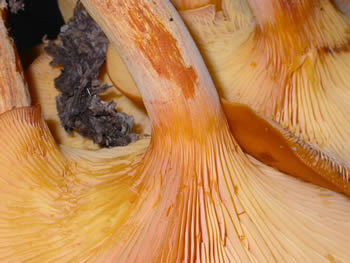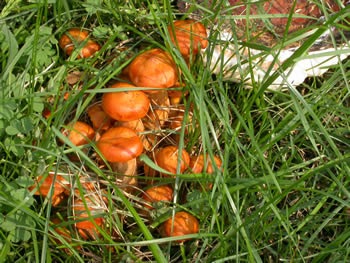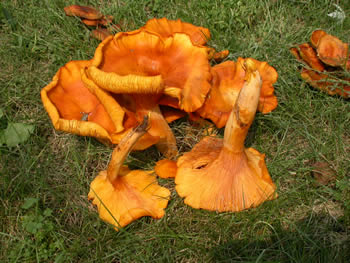
Welcome to the wonderful world of The Jack-O-Lantern….
Mushroom that is!
 Omphalotus olearius, more commonly know as the
Jack-O-Lantern Mushroom gets is name not only from its
orange color, but also from its bioluminescent properties.
Read more on my
Spooky Story page. To the common mushroom
hunter, it may appear to be a delectable treat but is
poisonous. While it rarely causes death, it may make the
consumer wish death upon themselves. In a recent study,
patients knowingly consumed the
O. olearius
mushroom in an effort to document the specific effects. Most
patients experienced 2 to 6 days of nausea, vomiting,
abdominal cramping, diarrhea, weakness and dizziness. If
this mushroom is consumed, it is advised to seek medical
attention for rehydration, have potassium levels checked,
and to receive baseline liver tests. (Vandenhoek 1991)
Despite the horrid side effects of consuming this mushroom,
many people have said that it tasted a
Omphalotus olearius, more commonly know as the
Jack-O-Lantern Mushroom gets is name not only from its
orange color, but also from its bioluminescent properties.
Read more on my
Spooky Story page. To the common mushroom
hunter, it may appear to be a delectable treat but is
poisonous. While it rarely causes death, it may make the
consumer wish death upon themselves. In a recent study,
patients knowingly consumed the
O. olearius
mushroom in an effort to document the specific effects. Most
patients experienced 2 to 6 days of nausea, vomiting,
abdominal cramping, diarrhea, weakness and dizziness. If
this mushroom is consumed, it is advised to seek medical
attention for rehydration, have potassium levels checked,
and to receive baseline liver tests. (Vandenhoek 1991)
Despite the horrid side effects of consuming this mushroom,
many people have said that it tasted a nd smelled so good
that they would consider trying it again. This mushroom is
sometimes called “The False Chanterelle”, because many
mushroom hunters have mistaken it for the desirable
Cantharellus cibarius. When mushroom hunting, these
two mushrooms can be distinguished by their appearance.
O. olearius possesses true gills while the Chanterelle
has forked ridges. Observe the differences on the pictures to
the left. In addition, the Chanterelle grows on live oak,
while O. olearius grows on dead trees and stumps.
nd smelled so good
that they would consider trying it again. This mushroom is
sometimes called “The False Chanterelle”, because many
mushroom hunters have mistaken it for the desirable
Cantharellus cibarius. When mushroom hunting, these
two mushrooms can be distinguished by their appearance.
O. olearius possesses true gills while the Chanterelle
has forked ridges. Observe the differences on the pictures to
the left. In addition, the Chanterelle grows on live oak,
while O. olearius grows on dead trees and stumps.
Appearance
The entire body of a Jack O’Lantern mushroom is orange in color. The size of their caps range from about 7 cm to 20 cm wide, and their heights range from 7 cm to 20 cm tall. When these mushrooms are young, the cap appears smooth and round. As the mushroom matures, the edges of the cap curve and widen out. Since the mushroom doesn’t release its spores until it is mature, the cap is curved down in the young fruiting bodies. As it reaches maturity and becomes ready to release its spores, the cap widens to allow maximum potential for spore dispersal. Observe the changes in the images below.


